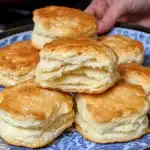Introduction
Nothing beats the smell of freshly baked biscuits drifting through the kitchen. Homemade biscuits are a staple in many households, offering a comforting and delicious treat that’s perfect for any occasion. Whether you’re a seasoned baker or a novice in the kitchen, making biscuits from scratch is a rewarding experience. In this guide, we’ll walk you through everything you need to know to make easy homemade biscuits that are fluffy, golden, and absolutely delicious. From the basic ingredients to common mistakes to avoid, we’ve got you covered. Let’s dive in!
Ingredients for Easy Homemade Biscuits
Basic Ingredients Needed
To make the perfect homemade biscuits, you’ll need a few basic ingredients that are likely already in your pantry:
Flour: The foundation of any biscuit recipe. All-purpose flour is most effective in achieving a well-balanced texture.
Baking Powder: This leavening agent facilitates the rising of the biscuits, resulting in a light and fluffy texture.
Salt: is essential for flavor. A small amount can lead to significant changes.
Butter: Adds richness and flakiness to the biscuits. Make sure it’s cold and cut into small pieces.
Milk: Helps to bind the ingredients together and creates a moist dough.
Optional Ingredients for Variations
For those who like to experiment with flavors, here are some optional ingredients you can add to your biscuits:
Cheese: Adds a savory twist to your biscuits. Cheddar works great.
Herbs: Fresh or dried herbs like rosemary or thyme can enhance the flavor.
Spices: A pinch of garlic powder or paprika can add a subtle kick.
Step-by-Step Guide to Making Biscuits
Preparing the Ingredients
Make sure to measure everything accurately and have all your items ready. This step ensures your recipe turns out just right and makes the process smoother.
Measuring the ingredients correctly: Use a kitchen scale for the best results. If you don’t have one, spoon the flour into your measuring cup and level it off with a knife.
Sifting the dry ingredients: This helps to aerate the flour and baking powder, ensuring a light and fluffy texture.
Mixing the Dough
The way you mix the dough can make or break your biscuits:
Techniques for cutting in the butter: Use a pastry cutter or two knives to cut the butter into the flour until it resembles coarse crumbs.
How to avoid overmixing: Mix just until the ingredients are combined. Overworking the dough can result in tough biscuits.
Shaping the Biscuits
Once your dough is mixed, it’s time to shape your biscuits:
Best practices for rolling and cutting the dough: Lightly flour your surface and roll the dough to about 1/2 inch thickness. Use a biscuit cutter or a glass to cut out the biscuits, pressing straight down without twisting.
Tips for uniform size and shape: Dip your cutter in flour between cuts to prevent sticking and ensure even shapes.
Baking the Biscuits
The final step is baking your biscuits to perfection:
Ideal oven temperature and baking time: Preheat your oven to 425°F (220°C) and bake for 12-15 minutes, or until golden brown.
How to tell when biscuits are done: Look for a golden color on the tops and bottoms, and they should feel firm to the touch.
Common Mistakes to Avoid
Overworking the Dough
One frequent mistake when making biscuits is overworking the dough. Overworking the dough can lead to tough, dense biscuits instead of the light and fluffy ones we all love. One of the keys to making perfect biscuits is to avoid overworking the dough. To achieve this, mix the dough only until the ingredients are just combined. If the dough appears a bit shaggy, that’s a good sign that you haven’t overmixed it. This technique helps ensure your biscuits turn out light and fluffy rather than tough and dense.
Incorrect Oven Temperature
Baking your biscuits at the wrong temperature can affect their rise and texture. An oven that’s too hot can cause the biscuits to brown too quickly on the outside while remaining undercooked inside. Conversely, an oven that’s not hot enough will result in biscuits that don’t rise properly. Always preheat your oven to 425°F (220°C) for the best results.
Using the Wrong Type of Flour
The type of flour you use can significantly impact your biscuits’ texture. All-purpose flour is the best choice for homemade biscuits because it provides a good balance of protein and starch. Self-rising flour can also be used but remember to adjust the baking powder and salt in your recipe accordingly.
Secrets to Excellent Biscuits
Choosing the Right Ingredients
Fresh, high-quality ingredients can make a big difference in your biscuits:
Importance of fresh ingredients: Fresh baking powder and flour ensure your biscuits rise well and taste great.
Recommended brands: Brands like King Arthur Flour and Bob’s Red Mill are known for their quality.
Proper Technique
Mastering the technique is key to making excellent biscuits:
Folding the dough for layers: For flaky layers, fold the dough over itself a few times before rolling it out.
Using cold butter: Cold butter creates steam as it melts during baking, leading to flaky biscuits.
Additional Tips
Here are a few more tips to help you bake the best biscuits:
Using a baking stone: A preheated baking stone helps the biscuits rise evenly.
Preheating the oven: Make sure your oven is fully preheated before you put the biscuits in to bake.
How to Make Mary Berry Biscuits
Ingredients for Mary Berry’s Biscuits
Mary Berry is known for her classic and reliable biscuit recipes. To make her biscuits, you’ll need:
Self-raising flour
Baking powder
Salt
Butter
Milk
Egg (optional, for glazing)
Steps to Follow
Follow these steps to make Mary Berry’s biscuits:
Mix the dry ingredients: Combine the flour, baking powder, and salt in a bowl.
Cut in the butter: Use your fingers or a pastry cutter to rub the butter into the flour until it resembles breadcrumbs.
Add the milk: Pour in the milk and stir until the dough comes together.
Shape and bake: Roll out the dough, cut into shapes, and bake at 425°F (220°C) for 10-12 minutes.
Tips for Success
Insights from Mary Berry’s baking philosophy: Keep everything cold, work quickly, and handle the dough as little as possible to ensure light and airy biscuits.
Best Flour for Homemade Biscuits
Types of Flour
Choosing the right flour is crucial for the texture of your biscuits:
All-purpose flour: Provides a balanced texture.
Self-rising flour: Contains added leavening agents.
Cake flour: Gives a lighter, more delicate texture.
Pros and Cons of Each
All-purpose flour: Versatile but requires additional leavening.
Self-rising flour: Convenient but can alter the taste.
Cake flour: Produces tender biscuits but may lack structure.
Expert Recommendations
Experts recommend using all-purpose flour for its balance of protein and starch. For a lighter biscuit, you can mix all-purpose flour with a bit of cake flour.
Frequently Asked Questions (FAQs)
What not to do when making biscuits?
Avoid overworking the dough and ensure your oven temperature is accurate.
How to make a Mary Berry biscuit?
Follow Mary Berry’s classic recipe with self-raising flour, cold butter, and milk.
What is the secret to an excellent biscuit?
Use fresh ingredients, cold butter, and handle the dough as little as possible.
What is the best flour for homemade biscuits?
All-purpose flour is the best choice for a balanced texture, but self-rising and cake flour can also be used for specific results.
Additional Questions
How do you store homemade biscuits?
Keep them in a sealed container at room temperature for a maximum of three days.
Can you freeze biscuit dough?
You are permitted to freeze the dough for a duration of up to three months. Thaw before baking.
What can you serve with homemade biscuits?
Biscuits pair well with butter, jam, gravy, or as a side to soups and stews.
Conclusion
Making easy homemade biscuits is a rewarding and straightforward process. By following the steps and tips in this guide, you’ll be able to create biscuits that are fluffy, golden, and delicious every time. Don’t be afraid to experiment with different flavors and techniques. Happy baking! Should you possess any insights or experiences to contribute, please feel free to leave a comment below.
Key Takeaways:
Use all-purpose flour for a balanced texture, or experiment with self-rising and cake flour for different results.
Ensure your ingredients are fresh and your butter is cold for the best outcome.
Follow the step-by-step guide to achieve fluffy, golden biscuits every time.

Easy Homemade Biscuits
Ingredients
Basic Ingredients Needed
- 2 cups All-purpose flour The foundation of the recipe.
- 1 tbsp Baking powder For leavening.
- 1/2 tsp Salt Essential for flavor.
- 1/2 cup Cold butter Cut into small pieces.
- 3/4 cup Milk To bind the ingredients.
Optional Ingredients for Variations
- 1 cup Cheese (e.g., Cheddar) For a savory twist.
- 2 tbsp Herbs (e.g., rosemary, thyme) For enhanced flavor.
- 1/2 tsp Spices (e.g., garlic powder, paprika) For added depth.
Instructions
Preparation
- Measure all ingredients accurately and prepare your workspace.
- Sift together the flour, baking powder, and salt.
Mixing the Dough
- Cut the cold butter into the flour mixture until it resembles coarse crumbs.
- Mix just until combined; do not overmix.
Shaping the Biscuits
- Roll out the dough to about 1/2 inch thickness on a floured surface.
- Cut out biscuits with a biscuit cutter or glass.
Baking the Biscuits
- Preheat the oven to 425°F (220°C).
- Bake biscuits for 12-15 minutes until golden brown.












